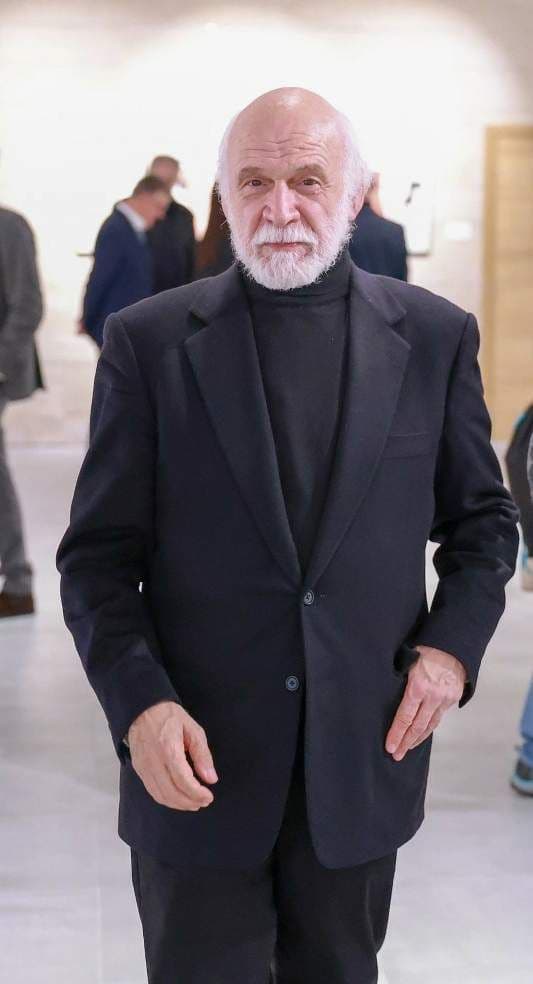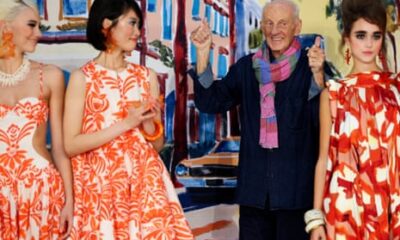Lifestyle
Montenegrin Artist Explores Fashion’s Depths at Milan Exhibition

In a vibrant setting at the Luciana Matalon Foundation in Milan, the exhibition titled “The Myth of Fashion” by Montenegrin artist Dimitrije Popović has opened to the public. The exhibition features approximately fifty works, ranging from paintings and drawings to installations and assemblages, that delve into fashion as an aesthetic, philosophical, and social phenomenon. A standout piece is the installation “Golden Hand,” a tribute to the late fashion designer Giorgio Armani, establishing a dialogue with a city that views the fashion spectacle as integral to its identity.
Popović’s series “The Myth of Fashion” represents an ambitious visual exploration where he perceives fashion not merely as a fleeting trend or an industrial mechanism, but as a deeply rooted cultural, symbolic, and semiotic phenomenon. Instead of recounting the history of fashion or presenting a series of aesthetic epochs, the focus is on the narrative emerging from the relationship between the body and what it adorns.
During a recent conversation, Popović discussed the essence of fashion as a contemporary myth and its role in shaping culture and identity.
“The exhibition ‘The Myth of Fashion’ had its premiere in Zagreb before arriving in Milan. How do you perceive this return to a city that symbolizes the global fashion scene?”
Popović responded, “The circumstances aligned perfectly. The theme of my exhibition harmonized with the atmosphere in Milan, the fashion capital. The organizers proposed the exhibition dates right after the conclusion of ‘Milan Fashion Week,’ aiming to artistically extend what occurred on the runways during that week. This exhibition belongs to the phenomenon of fashion but transcends the usual understanding of fashion as merely creating exclusive clothing items.”
The exhibition space spans 500 square meters, allowing Popović to display fifty-six works in a manner that simultaneously highlights aspects of fashion as spectacle and glamour while prompting reflection on the radical changes in the relationship between women’s bodies and their functions in the context of fashion in the 20th and 21st centuries.
Popović also differentiates the exhibition’s title “The Myth of Fashion” from “The Myth about Fashion,” emphasizing the importance of this distinction. He explained, “The word myth signifies a story. My series does not discuss fashion as a historical narrative or as a homage to a particular fashion era. Rather, it tells a story about how fashion generates and emerges from itself, from the body’s relationship with what it wears, where the attire shifts from a utilitarian garment to a performative expression of the body.”
Popović draws on a historical continuum, noting that the concept of fashion began when, according to Judeo-Christian tradition, Adam and Eve covered their bodies out of shame. He elaborated on how the act of covering the body has led to evolving forms of clothing, enriching fashion with categories of aestheticization, eroticization, and even fetishism.
The artist attributes a profound significance to the philosophical insights of Roland Barthes, who was among the first to perceive fashion as a complex phenomenon enriched with semiotics, distinguishing it from mere dressing.
Popović describes fashion as a dynamic entity that “kills itself to live.” He elaborated, “Fashion is a unique phenomenon in human culture. We witness its changes and the dictates of clothing styles. When one style reaches its peak, another is already preparing to replace it. To maintain its vitality, fashion must eliminate its previous forms in favor of those that become current and dominant.”
In his works, Popović connects fashion with philosophical and theological dimensions, bridging the mythical and contemporary layers of human existence. He stated, “When it comes to the human body, the religious-philosophical components are inherent. The cultural arc from the fig leaves covering Adam and Eve to modern models presents a fascinating image of transformation within fashion signs and meanings.”
His installation pieces, such as “Black Wedding Dress” and “Bride’s Dawn,” reflect the interplay of visibility and concealment in the representation of the body. According to Popović, the “fashion body” today symbolizes societal expectations and the cultural zeitgeist, mirroring the era in which it exists.
“The fashion body is inherently a social body, reflecting the time it shows itself. It is multiplied within the virtual networks of contemporary culture,” he noted. “I am particularly drawn to monumental posters of major fashion houses that dominate urban spaces, showcasing perfected, photoshopped bodies and faces of models.”
The artist’s reflection on modern trends, including the aestheticization of the body through botox, lifting, and digital filters, highlights the pressures faced by individuals to conform to an idealized image.
Popović argues that the boundary between fashion and high art is increasingly blurred. He pointed out that while fashion belongs to the realm of applied arts, the creativity of designers has led to their works being exhibited in prestigious museums. For instance, Giorgio Armani showcased his creations at the Guggenheim Museum in New York, while Alexander McQueen had a posthumous exhibition at the Metropolitan Museum, which was among the ten most popular exhibitions ever held in the United States.
Reflecting on the contemporary spectacle of society, Popović believes that it inspires rather than burdens the artist. He stated, “The spectacle has become a phenomenon of modern society. Every artist reacts to the character of their time according to their sensitivity and relationship to society, articulating it through their work.”
Popović emphasizes that art must penetrate the essence of the world rather than serve merely as decoration, stating, “Art should not provide a false image of reality. It is the artist’s task to reflect on the processes they live through.” He perceives fashion as one of the symbols of human transience, recognizing its role in highlighting the tragic nature of human existence.
In conclusion, Dimitrije Popović’s “The Myth of Fashion” is not just an exhibition; it is a profound exploration of the cultural implications of fashion, serving as a mirror reflecting the complexities of identity and existence in contemporary society. The exhibition is open to the public at the Luciana Matalon Foundation, inviting visitors to engage with the intricate narratives woven through the fabric of fashion.
-

 World5 days ago
World5 days agoCoronation Street’s Shocking Murder Twist Reveals Family Secrets
-

 Entertainment4 months ago
Entertainment4 months agoKate Garraway Sells £2 Million Home Amid Financial Struggles
-

 Entertainment3 months ago
Entertainment3 months agoAnn Ming Reflects on ITV’s ‘I Fought the Law’ Drama
-

 Entertainment3 days ago
Entertainment3 days agoAndrew Pierce Confirms Departure from ITV’s Good Morning Britain
-

 Health3 months ago
Health3 months agoKatie Price Faces New Health Concerns After Cancer Symptoms Resurface
-

 Entertainment4 weeks ago
Entertainment4 weeks agoCoronation Street Fans React as Todd Faces Heartbreaking Choice
-

 World4 weeks ago
World4 weeks agoBailey Announces Heartbreaking Split from Rebecca After Reunion
-

 Entertainment1 week ago
Entertainment1 week agoTwo Stars Evicted from I’m A Celebrity Just Days Before Finale
-

 World1 week ago
World1 week agoKevin Sinfield Exceeds Fundraising Goal Ahead of Final Marathons
-

 Entertainment3 months ago
Entertainment3 months agoCoronation Street’s Carl Webster Faces Trouble with New Affairs
-

 Entertainment3 months ago
Entertainment3 months agoWhere is Tinder Swindler Simon Leviev? Latest Updates Revealed
-

 Entertainment4 months ago
Entertainment4 months agoMarkiplier Addresses AI Controversy During Livestream Response



















